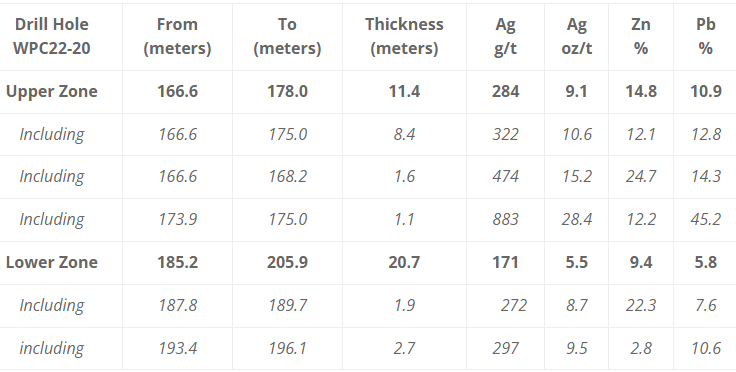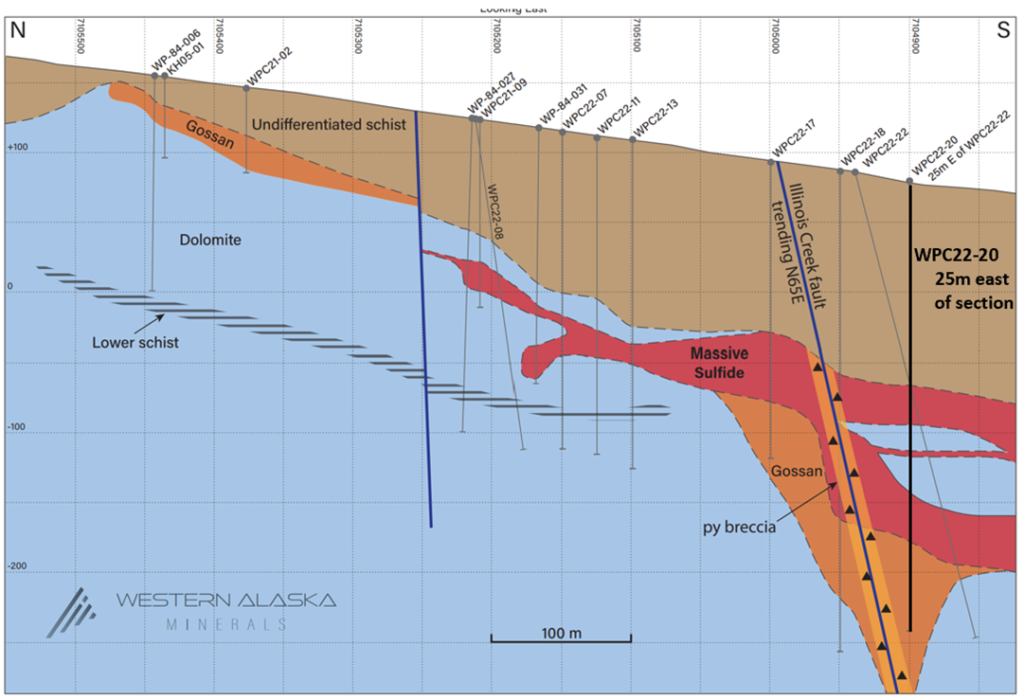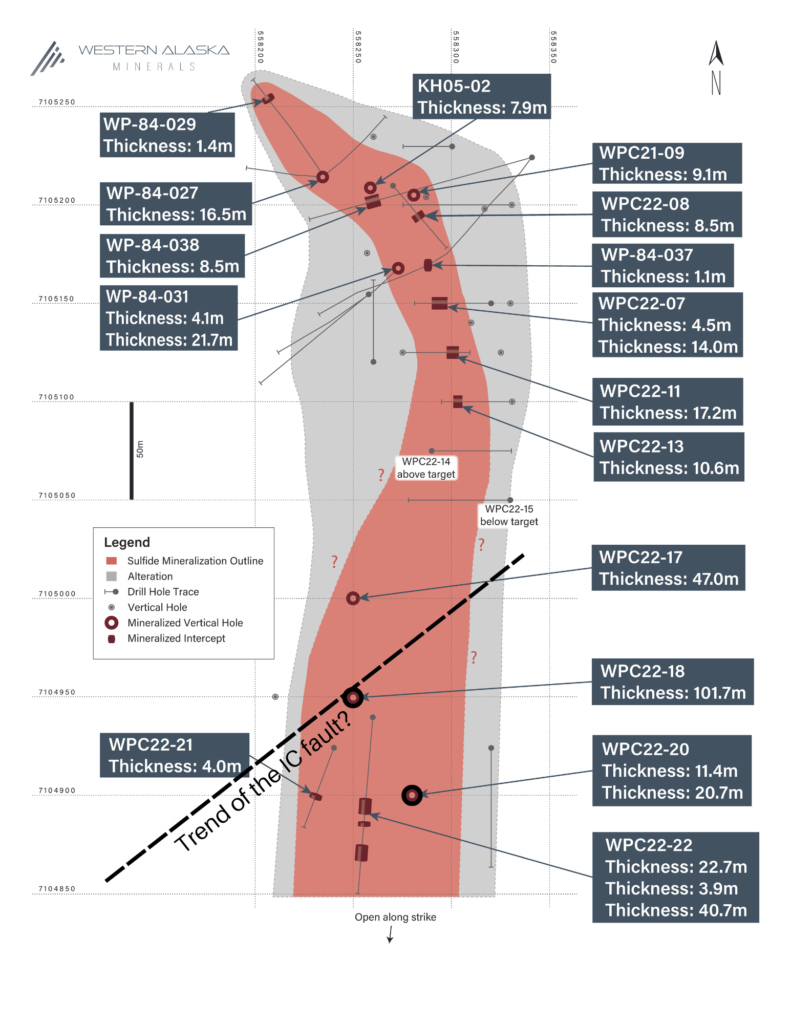Western Alaska Minerals (the “Company” or “WAM”) is pleased to announce drill assay results from WPC22-20 which intersected two thick multistage massive sulfide horizons for which visuals were announced previously (See News Releases of August 2 and September 22, 2022) at its 100% owned Waterpump Creek Carbonate Replacement Deposit. The upper intercept cut 1.1 meters grading 883 grams/tonne (“g/t”) Silver (28.4 ounce/tonne (“oz/t”)), 45.2% Lead and 12.2% Zinc within 11.4 meters grading 284 g/t Silver (9.1 oz/t), 10.9% Lead and 14.8% Zinc. The lower intercept cut 2.7 meters grading 297 g/t Silver (9.5 oz/t), 10.6% Lead and 2.8% Zinc within 20.7 meters grading 171 g/t (5.5 oz/t) Silver, 5.8% Lead and 9.4% Zinc.
The discussion below incorporates visual data from drillholes WPC22-21 and 22, for which assay data are pending, and from previous drill holes (See News Release of September 22, 2022). Mineralization remains open and will be the focus of the 2023 drill program.
Highlights of Hole WPC22-020
WPC22-020 is located 50 meters south and 25 meters west of WPC22-018, which cut 101m of massive sulfides interpreted as a feeder chimney (See News Release of September 22)
The WPC22-20 high-grade intercepts appear linkable to high-grade zones in the interpreted WPC22-018 chimney
Both intercepts show classic multi-phase CRD-style massive sulfide mineralization with silver-rich lead mineralization stages cutting earlier zinc-rich stages (See Table 1)
Similar mineralization has now been cut at similar elevations in 10 drill holes indicating a continuous elongate body 30 to 75 meters wide and 400 meters in length (See Figure 2)
“These two thick intercepts tie together with similar mineralization in nine other holes to give us 400 meters of continuous high-grade mineralization fed from the chimney we cut in WPC22-018,” said Kit Marrs, Western Alaska Minerals CEO. “This discovery stems from our technical team’s follow-up on last year’s initial intercept in the zone. We think we’ve latched onto a major silver-lead-zinc system so the Company has purchased three more drill rigs for more aggressive exploration starting next spring.”
Assay Results
Hole WPC22-20 encountered two significant intercepts of massive to semi-massive sphalerite and argentiferous galena in a matrix of secondary dolomite like that seen in previous drilling (See Press Releases of July 20 and August 2). The intercepts are separated by 7 meters of weakly to unmineralized host rock. Both intercepts clearly show multiple cross-cutting stages of mineralization, highlighted by distinctive zones of silver-rich galena cutting separate lower-silver sphalerite stages. There are at least two separate stages of sphalerite. The uppermost interval has only minor pyrite while the lower interval has a much higher pyrite content, but neither intercept shows the massive pyrite stage shown in WPC22-18 (See Press Release of September 22).
Data from this release continue to show a strong correlation between silver and lead with each 1% lead associated with approximately 1 oz/t silver. Zinc grades appear far more variable and reflect different stages of mineralization.
Table 1 shows highlight assay results from drill hole WPC22-20. Full results can be found on
Table 1. Assay results

Waterpump Creek Drilling: Discussion
Combining the results from the first 23 holes drilled into the Waterpump Creek structural zone allows recognition of a continuous elongate ribbon (“manto”) of massive sulfides 30 to 75 meters wide and 400 meters in length plunging gently to the south (Figures 1 and 2). The mineralization affects reactive dolomite lying beneath an impermeable schist along the WPC Creek structure. Hole WPC22-18 lies at the intersection of the WPC and Illinois Creek structures and cut 103 meters of massive sulfides (See Press Release of September 22, 2022). The mineralization in WPC22-18 includes sections with mineralogy and grades similar to those of WPC22-20 and all the other sulfide-bearing holes in the area, but also includes a late massive pyrite stage that is not seen in the surrounding holes. The combination of the location of WPC22-18 at a major structural intersection, the presence of multiple zones of multi-stage high-grade Ag-Pb-Zn sulfides that thin progressively through the surrounding holes, and the late pyrite stage strongly suggest that WPC22-18 cut a “feeder” chimney through which mineralizing fluids rose before traveling laterally through WPC22-20, etc., to create the emerging elongate sulfide manto.
“The multi-stage high-silver mineralization cutting across the multi-stage high-zinc mineralization seen in WPC22-20 indicates that a long-lived source pumped one pulse of metal-bearing fluids after another into the system’s plumbing,” said Dr. Peter Megaw, Exploration Advisor to WAM. “Once you see that kind of system strength it is time to look around for more because very few CRD systems have only one spoke to their wheel and you can track them back to the intrusive hub, which at Illinois Creek is likely a porphyry copper deposit”.
.

Figure 1. Updated longitudinal-section down the axis of the Waterpump Creek manto showing how it runs beneath the overlying schist and thins progressively to the north from the WPC22-18 Chimney. Note how the manto maintains very significant thickness to the south into WPC22-20 and how the highest-grade upper part of the manto can be traced continuously for 400 meters. Note also the pyrite zone concentrated along the interpreted Illinois Creek Fault and how late movements along the fault have allowed surface waters to infiltrate and oxidize the pyrite and surrounding sulfides to a massive gossan.

Figure 2. Pierce point plan map of 2022 drilling at Waterpump Creek showing the emerging shape of the Waterpump Creek Manto and the location of the WPC22-18 Chimney at the interpreted intersection of the WPC Graben and the projected trend of the Illinois Creek fault. Note the continuation of strong manto mineralization to the south into WPC22-20 and 22 and that the manto remains open to the south along this principal axis as well as laterally.
Plans Going Forward:
As a result of the drilling achievements in 2022, coupled with the closing of a C$12 million financing in August/September, 2022, WAM is planning for success in 2023. Three new company owned drill rigs will focus on following the Waterpump Creek high-grade manto with 15,000 meters of drilling proposed. The goal will be to extend the manto along strike and includes resource definition drilling. Our two existing drill rigs will be tasked with exploring the multiple similar intersections of North-South structures with the through-going Illinois Creek Fault with an additional 10,000 meters of drilling.
The existing camp will be expanded to accommodate crews for the five drill rigs. Camp material, equipment and new fuel storage have been transported to Illinois Creek so that operations will be ready to ramp up in early spring, 2023.
(Source: Press Releases – www.westernalaskaminerals.com/news/news-releases/western-alaska-minerals-announces-two-thick-high-grade-mineralized-intervals-from-waterpump-creek)
Please send your press releases to press@miningnewspaper.com or juan.lamadrid@miningnewspaper.com